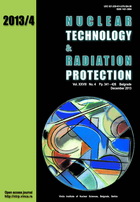
FEASIBILITY STUDY OF THE UNIVERSITY OF UTAH TRIGA REACTOR POWER UPGRADE
Part II: Thermohydraulics and Heat Transfer Study in Respect to Cooling System Requirements and Design

Vol.
XXVIII, No. 4, Pp. 341-426
December 2013
UDC 621.039+614.876:504.06
ISSN 1451-3994
Pages: 352-361
Authors: Philip Babitz, Dongok Choe, Tatjana Jevremovic
Abstract
The thermodynamic conditions of the University of Utah's TRIGA Reactor were simulated using SolidWorks Flow Simulation, Ansys, Fluent and PARET-ANL. The models are developed for the reactor's currently maximum operating power of 90 kW, and a few higher power levels to analyze thermohydraulics and heat transfer aspects in determining a design basis for higher power including the cost estimate. It was found that the natural convection current becomes much more pronounced at higher power levels with vortex shedding also occurring. A departure from nucleate boiling analysis showed that while nucleate boiling begins near 210 kW it remains in this state and does not approach the critical heat flux at powers up to 500 kW. Based on these studies, two upgrades are proposed for extended operation and possibly higher reactor power level. Together with the findings from Part I studies, we conclude that increase of the reactor power is highly feasible yet dependable on its purpose and associated investments.
Key words: TRIGA, research reactor, heat transfer, FLUENT, SolidWorks, PARET
FULL PAPER IN PDF FORMAT (1,76 MB)